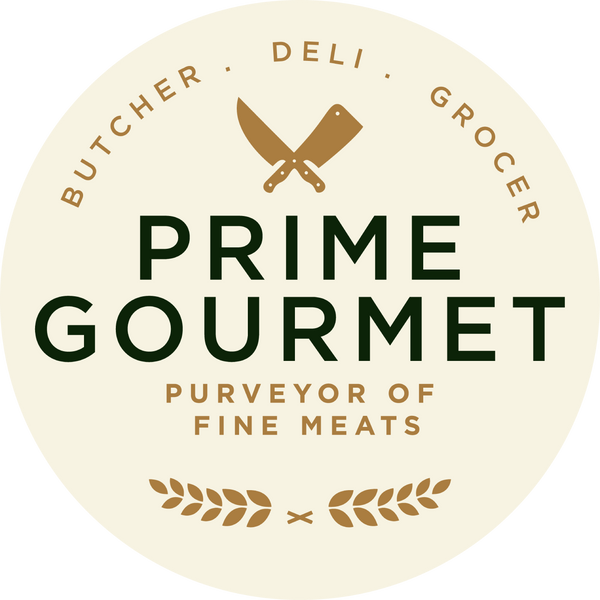Here at Prime Gourmet, our deli store and online butcher’s shop offers a huge array of different beef products, ranging from luxurious Australian Wagyu and Japanese Wagyu, to premium Black Angus, and much more. As you are browsing, you may notice that our descriptions take care to mention the marbling of each different meat, and give each one a marbling score, too.
If you are new to buying and cooking meat at home, you might be wondering why this is, and what ‘marbling’ actually means. So, we have decided to take a deep dive into meat marbling, exploring why it’s important to make note of the marbling when buying beef, and how it will impact your finished recipes.
What is meat marbling?
When it comes to the marbled meat meaning, it refers to the small, thin white flecks of intramuscular fat that are visible in raw beef. Marbling refers to the small, thin white flecks of intramuscular fat that occur in raw beef. The appearance of this fat is similar to the pattern found on marble, and hence the term ‘marbled meat’ was derived.
There are many different types of marbling, and they all play a part in the overall ‘eating experience” of the meat. Marbling has a huge impact on taste, texture, and quality, and meats with a higher marbling grade tend to be juicier and more tender, too. When cool, the marbling fat is white and more obvious to see. However, once a piece of meat is cooked, the fats begin to melt and the marbling becomes more discreet.
How is marbling scored?
The marbling grade tells you how much marbling is in a piece of meat. In Japan, Australia, and the USA, expert graders appraise marbling in each animal, and give it a marbling score based on the quantity of marbling, and the distribution and texture of the marbling as well.
Meat scored 0 has no discernible marbling, whereas premium meats such as Wagyu marbling score tend to have between six and 12. For instance, our succulent Wagyu beef ribeye steak and minute steaks from Stockyard Beef both have marbling grades of 6-7, while our Australian Kiwami Wagyu picanha has a marbling grade of 9 and above.
How does wagyu marbling impact taste?
When it comes to taste and texture, the general rule is the more marbling the better. As there is less muscle fibre and collagen per unit volume, heavily marbled meats are softer and easier to chew. High levels of marbling creates a melt-in-the-mouth texture that is often associated with
Wagyu and other premium meats, and it makes meat more flavourful, too. Less chewing is required before the flavour is released, and the taste is noticeably sweeter and juicier, with more delicious meat juice produced, too.
Is marbled meat healthy?
You might naturally presume that beef with less marbling - and therefore less fat – is a healthier option than highly marbled meat. But in reality, the opposite is true. While some types of fats are undeniably bad for you, the intramuscular, unsaturated fat that creates marbling can actually be good for you.
Top-shelf breeds like Wagyu have high levels of ‘healthier’ fats like oleic acid, a fatty acid that is commonly used to help prevent heart disease and reduce cholesterol, and other Omega-3s that can bring protection against arthritis, depression, and Alzheimer's.
What creates marbling?
As mentioned above, marbling is an indicator of quality, and marbling levels are mainly determined by the cattle’s genetics and nutrition, and also age and activity levels.
Breed
Some cattle breeds naturally have higher marbling scores due to the way they metabolise food. For instance, Australian Wagyu, Japanese Wagyu and Black Angus all naturally have high levels of marbling. At Prime Gourmet, we offer a wide array of 100% halal products from all three of these different breeds, including steaks, burgers, pies, mince, and more.
Nutrition
How and what the cattle is fed on also plays a part. For instance, at Prime Gourmet, we offer a wide array of delicious grass-fed beef products from Silver Fern Farms, one of New Zealand’s most ethical and sustainable beef producers. On the other hand, our delicious Australian Wagyu from Stockyard Beef are fed on a precisely measured mix of both grass and grain.
Muscle
Muscles in the cattle that are less heavily worked – such as the loin – have more fat and therefore more marbling than active and lean muscles such as those in the leg, shoulder, and rump.
Age
Young cattle haven’t had the chance to develop marbling, while older animals don’t have ideal amounts of marbling either.
Premium marbled meats from across the globe
As you can see, there are various aspects that impact meat marbling. Thankfully, Prime Gourmet takes care of the hard work and selects only the finest, top marble-graded products from across the world for you to cook and enjoy at home.
If you’re looking for inspiration for your next steak night in, take a browse through our full range of tender marbled Wagyu here. Our selection includes beef cuts with the highest marbling scores, ensuring a luxurious and tender eating experience.

